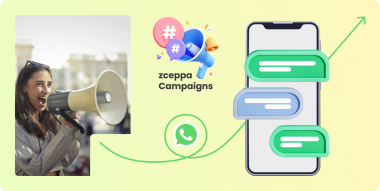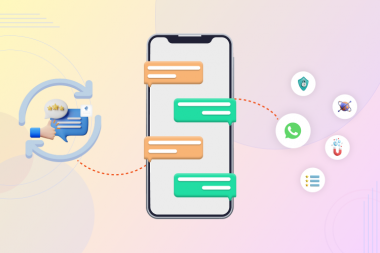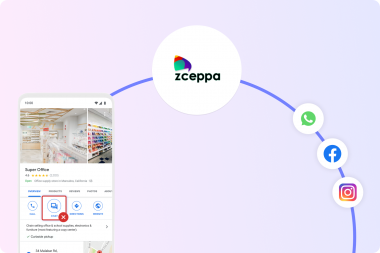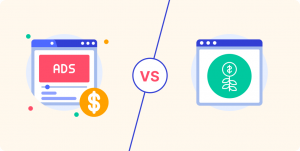Paid Social vs. Organic: Crafting a Balanced Social Media Strategy
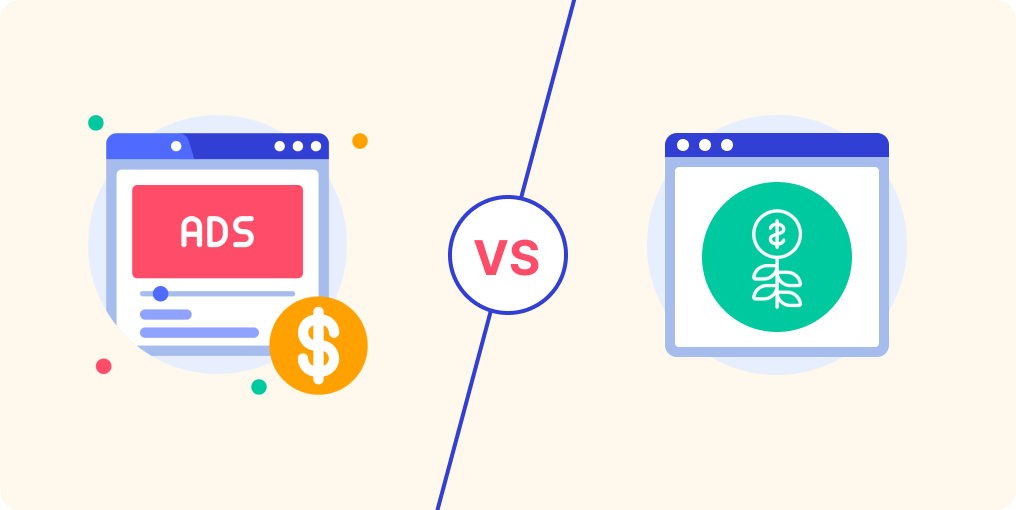
With around 4.95 billion active users across various platforms, social media has evolved into a powerful tool for building brand awareness, fostering customer engagement, and driving sales. However, navigating the complexities of social media marketing requires a strategic blend of organic and paid social efforts. While organic endeavors lay the groundwork for authenticity and community building, paid strategies offer unparalleled reach and targeting capabilities.
This blog will guide you on how to effectively harness the synergy between organic and paid social media efforts to achieve your marketing goals. Join us as we delve into actionable insights and best practices for optimizing your paid social media campaigns and maximizing your online presence.
What is Organic Social Media?
Organic social media refers to the practice of using social media platforms to share free content, engage with followers, and build a community without relying on paid promotions or advertisements. Content includes regular posts, stories, live streams, and short videos that resonate with users.
Key to organic social media is the interaction between the brand and its followers, such as through comments, replies, likes, and shares, fostering a sense of community and trust.
What is Paid Social Media?
Paid social media is when businesses spend money to promote their content or messages on social media platforms. Let us understand this with the help of an example-
The image below showcases a doctor’s Instagram post. The “Boost Option” highlighted in red indicates that this is an organic post that has yet to be boosted or advertised.
Now, you can boost posts on Instagram, which is exactly what this image shows. The “Boost again” option indicates that this particular post has been boosted (advertised) before and is hence an example of a paid social media ad.
The following image depicts how a boosted or advertised post appears on social media. It is this sponsored label that indicates that the post is not organic, instead a paid social post-
The Importance of Enhancing Local Digital Presence with Paid Social Media
In an era where digital interactions are pivotal, businesses must prioritize enhancing their local digital presence across all social media platforms. Paid social media strategies offer a powerful means to achieve this, providing a range of benefits that can drive growth and visibility. Here are some compelling reasons why businesses should invest in paid ads:
| Did You Know In 2023, paid social spending was around 270 billion U.S. dollars. This expenditure was expected to reach 300 billion dollars by 2024. |
The Symbiotic Relationship Between Digital Presence and Paid Social Media
A robust digital presence doesn’t just support organic growth; it significantly amplifies the effectiveness of paid social media campaigns. Here’s how:
- Enhanced Credibility and Trust:
- A strong local digital presence builds credibility. When potential customers see positive reviews, high ratings, and consistent engagement, they are more likely to trust the business.
- Trust is a crucial factor in driving clicks and conversions from paid social media ads. For instance, an ad showcasing a high Google review rating or customer testimonials can significantly boost click-through rates (CTR) and conversion rates.
- Increased Click-Through Rates (CTR):
- Advertisements that feature social proof, such as customer reviews and ratings, tend to perform better. When users see that others have had positive experiences, they are more likely to click on the ad.
- Utilizing review badges, like those from Google, within your ads can provide immediate validation and encourage clicks.
- Higher Conversion Rates:
- A stellar online reputation not only attracts clicks but also increases the likelihood of conversions. Users are more inclined to purchase from a business that has a proven track record of satisfied customers.
- By integrating customer feedback and ratings into paid social media campaigns, businesses can reduce friction in the decision-making process for potential customers.
- Better Ad Performance Metrics:
- Ads that incorporate elements of a strong digital presence often see improved performance metrics, such as lower cost per click (CPC) and higher return on ad spend (ROAS). This is because platforms like Facebook and Instagram reward ads that resonate well with audiences through better placement and reduced costs.
Leveraging Digital Reputation in Paid Social Campaigns
Marketers can strategically use various elements of their digital presence to enhance their paid social media campaigns:
- Review Badges and Ratings:
- Featuring Google review badges and star ratings in ad creatives can immediately capture attention and build trust.
- Highlighting positive customer reviews within the ad copy or visuals can provide compelling reasons for potential customers to engage with the ad.
- Customer Testimonials and Stories:
- Sharing authentic customer testimonials or success stories in video or carousel ads can humanize the brand and build a deeper connection with the audience.
- User-generated content (UGC) that showcases real customer experiences can be particularly effective in driving engagement and conversions.
- Consistent Brand Messaging:
- Ensuring that the messaging in paid social ads aligns with the overall brand narrative and customer experience as reflected in reviews and social media presence can create a cohesive and trustworthy brand image.
- Consistent messaging helps reinforce the brand’s value proposition and reliability.
- Localized Campaigns:
- Local businesses can benefit from running geo-targeted ads that highlight their strong local reputation. Ads featuring local customer reviews and community involvement can resonate more with the target audience.
- Emphasizing proximity and local engagement can drive foot traffic and local sales, further enhancing the business’s presence in the community.
Paid Social vs. Organic Posts- Which is More Effective?
Let’s look at the key differences between organic and paid social media strategies, helping to understand their distinct roles-
| Cost | Free, no costs involved | Involves financial expenditure for advertisements |
| Reach | Limited to followers and their networks. The reach is slow here | Can target specific audiences, broader and faster reach |
| Content | Relies on high quality, engaging posts, stories and interactions | Structured, promotional content designed for ads |
| Engagement | Based on natural interactions like comments, likes, and shares | Often higher initial engagement due to targeted exposure |
| Feature | Organic Social Media | Paid Social Media |
| Longevity | Long-term, ongoing strategy for sustained community growth | Short-term, focused on immediate results and conversions |
| Targeting | Relies on organic reach, hashtags, and follower interaction | Advanced targeting options like demographics, interests, and behaviors. |
| Analytics | Basic insights from platform analytics | Detailed metrics and analytics to measure ad performance |
| Credibility | Often perceived as more authentic and trustworthy | May be seen as more commercial or promotional |
| Examples of Activities | Posting regular updates, engaging with followers, user-generated content | Running ads, sponsored posts, promotional campaigns |
| Purpose | Building brand loyalty, community engagement, organic growth | Driving immediate sales, lead generation, brand awareness |
The discussion of Paid Social vs. Organic Posts takes center stage in strategizing. But it is important to understand that in reality, it is their synergy that holds the key to unlocking greater success. Paid ads work wonders where there is organic content on your social media page, and likewise, organic posts are meaningful only when you attract more followers via paid posts. Hence, a cohesive strategy for a hybrid social media profile that integrates both paid and organic posts is essential for maximizing the impact of your online presence.
How to Maintain the Synergy Between Paid Social and Organic Content
A hybrid profile that combines both paid social and organic posts optimizes resources and maximizes results to achieve your marketing goals effectively, ensuring consistency in brand messaging, enhanced brand recognition, and excellent overall engagement with your audience. Here are some tips on how to maintain the synergy between paid social and organic content –
1. Identifying Indicators That Suggest a Post Is Worth Boosting
Look for organic posts that have performed exceptionally well in terms of engagement metrics such as likes, comments, shares, and clicks. These indicators suggest that the content has resonated with your audience and has the potential to perform even better with additional reach through paid promotion.
2. Set a Clear Objective
Before boosting a post, define your specific goals and objectives. Whether you aim to increase brand awareness, drive website traffic, generate leads, or boost sales, having a clear objective will guide your strategy and help measure the success of your paid social media efforts.
3. Target the Right Audience
Utilize the advanced targeting options provided by social media platforms to ensure your boosted post reaches the most relevant audience. Define your target audience based on demographics (age, gender, location), interests, behaviors, and other relevant criteria to maximize the impact of your paid promotion.
4. Best Time and Duration of Paid Social
Learn the best time to boost your post to maximise its visibility and engagement. Consider factors such as your target audience’s online behavior, peak activity times on social media, and the lifespan of your content to schedule the boost for maximum impact. Experiment with different timing and duration options to determine what works best for your audience and objectives
5. Cross-Promotion of Content
Leverage your organic and paid social media channels to cross-promote content and maximize visibility. Share links to your boosted posts on your organic profiles, website, email newsletters, and other marketing channels to reach a wider audience and drive engagement
6. Content Calendar and Optimization
Develop a content calendar to plan and schedule your organic and paid posts in advance. This allows you to maintain a consistent posting frequency, align content with key events or promotions, and optimise content based on past performance and audience feedback.
7. Social Listening
Monitor conversations, mentions, and feedback related to your brand, industry, and competitors on social media. Use social listening tools to gather insights, identify trends, and engage with your audience in real-time, informing your content strategy and boosting efforts.
8. A/B Testing
Experiment with different ad creatives, copy variations, targeting options, and campaign settings through A/B testing to identify what resonates best with your audience and drives the desired outcomes. Test one variable at a time and analyze the results to optimize your paid social media campaigns for maximum effectiveness.
5 Platforms for Running Paid Social Media Content
Social media platforms offer businesses the opportunity to reach their target audience through paid advertising. Here’s a brief overview of some popular platforms and their paid ad options:
1. Instagram
Instagram is the most popular social media platform in India with about 516.92 million active Instagram users in India.
With its visual-centric nature, Instagram is popular among younger demographics and businesses looking to showcase products or services through captivating visuals. Ad formats include photo ads, video ads, carousel ads, and stories ads.
2. Facebook
Facebook is the second most popular platform in India with over 492.70 million active internet users.
Known for its versatile content types and detailed targeting options, making it suitable for a wide range of businesses and industries. Facebook Ads allow businesses to create highly targeted ad campaigns based on demographics, interests, behaviors, and more. Ad formats include image ads, video ads, carousel ads, and more.
3. X (Twitter)
With over 42.90% penetration in India, Twitter is ideal for real-time engagement and hashtag campaigns, Twitter is a platform where businesses can join conversations, share updates, and connect with their audience at the moment. Ad formats include promoted tweets, promoted accounts, and promoted trends.
4. LinkedIn
With a focus on professionals and B2B networking, LinkedIn has captured 35.7% of social media users in India. It offers individuals and businesses opportunities to share professional content, network with industry peers, and advertise to a targeted audience. Ad formats include sponsored content, sponsored InMail, display ads, and text ads.
5. Google Business Profile
While not traditionally considered a social media platform, Google Business Profile allows businesses to manage their online presence and engage with customers through search ads, display ads, video ads, and more across Google’s network of websites and platforms, including YouTube and the Google Display Network.
What to Promote via Paid Social Media?
When it comes to promoting social media content, businesses can leverage various types and formats to create diverse and engaging paid social media campaigns that resonate with their target audience and drive meaningful results.
Here’s a quick rundown of different content types and post types that perform well with paid social media:
Content Types and Formats
1. Videos
Whether short-form, long-form, or live, videos are highly engaging and can effectively capture the attention of your audience. While short-form videos are perfect for delivering a concise message, long-form videos allow for more in-depth storytelling and can be used to educate, entertain, or inspire your audience. Additionally, live streaming allows for real-time interaction with your audience, fostering authenticity and engagement.
| Did You Know? Bite-sized short-form videos are dominating social media, capturing the attention of 66% of consumers. |
2. Images
High-quality images that are visually appealing and aligned with your brand’s aesthetics can attract attention and convey your message effectively. On the other hand, infographics combine visuals with text to present information or data in an effective and easy-to-understand format.
3. Carousel Posts
With the ability to showcase a series of images or videos in a single post, carousel posts allow for more storytelling and engagement opportunities. This provides a more immersive experience for your audience.
4. Stories
Stories are short-lived, disappearing after 24 hours, which creates a sense of urgency and encourages immediate engagement. You can also add stickers, polls, questions, and other interactive features to encourage audience participation and interaction.
5. Text-Based Posts
Use text-based posts to make important announcements, share updates, or convey information about your products or services. You can also promote special offers, discounts, or sales events.
6. User-Generated Content
Sharing content created by your customers, such as testimonials, reviews, or user-generated photos, can build trust and credibility with your audience.
7. Interactive Content
Interactive content like polls and quizzes, encourage audience participation and provide valuable insights into your audience’s preferences, interests, and behaviors. Moreover, running contests or giveaways can generate excitement, increase engagement, and grow your social media following.
Post Types:
Product Launches and Announcements:
Use paid social media to announce new products, services, or features to generate excitement and anticipation among your audience. Highlight the unique selling points of your product or service and showcase how it solves a problem or fulfills a need for your target audience.
Special Promotions and Discounts:
Boost posts promoting limited-time offers, sales, or discounts to create a sense of urgency and encourage immediate action from your audience. Clearly communicate the details of the promotion, including the discount amount, duration, and any applicable terms or conditions.
High-Performing Organic Posts:
Identify organic posts that have resonated well with your audience based on engagement metrics such as likes, comments, and shares. Boosting these posts can help extend their reach to a larger audience and capitalize on their existing popularity.
Customer Testimonials and Reviews: Share content featuring positive feedback from satisfied customers, such as testimonials, reviews, or user-generated content. This content can build trust and credibility with potential customers, providing social proof of your product or service’s quality and value.
Posts with Strong Call to Actions (CTAs):
Include clear and compelling calls to action in your boosted posts to drive specific actions from your audience, such as visiting your website, signing up for a newsletter, or making a purchase. Use actionable language and create a sense of urgency to prompt immediate engagement from your audience.
Event Promotions and Recaps:
Use paid social media to promote upcoming events, such as product launches, webinars, conferences, or workshops. After the event has concluded, share recaps, highlights, or behind-the-scenes content to extend the reach and engagement of the event.
How Can Zceppa Help?
Zceppa is the powerhouse platform designed to revolutionize your approach to social media marketing. Tailored for multi-location businesses, SaaS marketers, and astute professionals alike, Zceppa Social offers a wealth of features meticulously crafted to drive results.
Our platform empowers you to transcend traditional marketing boundaries and propel your brand to new heights of success. Harness the power of ready-made templates, dynamic content creation, and one-click post-sharing to effortlessly captivate your audience and leave a lasting impression. Leverage the power of automation and enhanced analytics to streamline your workflow and unlock invaluable insights into audience behavior.
Furthermore, with Zceppa Social’s scheduling capabilities and configurable templates, you’ll command attention with every post and drive unparalleled engagement. Join the ranks of industry trailblazers and unlock the full potential of your social media marketing efforts with Zceppa – where innovation meets excellence.
Results Delivered
Boost in engagement
8X
Increase in consumer actions
Conclusion
As we wrap up, Paid social media advertising offers businesses unparalleled opportunities to amplify their reach and drive measurable results across various platforms. By investing in paid ads, businesses can target specific audience segments and tailor their messaging to maximize engagement and conversions.
However, the synergy between paid and organic efforts is crucial for long-term success. Maintaining a hybrid profile that incorporates both paid and organic content allows businesses to maximize their online presence and achieve a balanced approach to social media marketing. By setting clear objectives, targeting the right audience, optimizing content, and embracing experimentation, businesses can unlock sustained growth and success.
With its plethora of features including ready templates, dynamic content creation, one-click post sharing, automation, enhanced analytics, scheduling, and configurable templates, Zceppa empowers businesses to elevate their social media presence and drive tangible results.
Schedule a Demo with Zceppa and unlock social media efficiency.
Signup for a free trial
Zceppa’s products empower your business to win every mobile-first consumer interaction across the buying journey.
